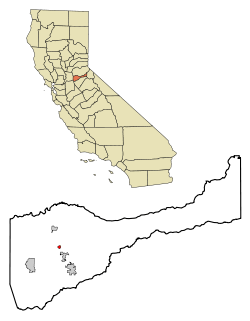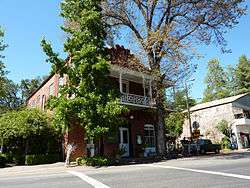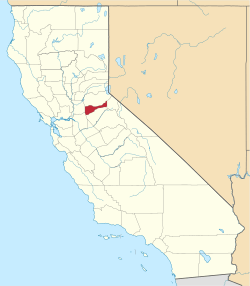Amador City, California
| Amador City, California | |
|---|---|
| City | |
|
Historic buildings in Amador City | |
| Nickname(s): The gold country’s hidden nugget | |
| Motto: "Essence of the California Gold & Wine Country" | |
 Location of Amador City in Amador County and California | |
 Amador City, California Location in the United States | |
| Coordinates: 38°25′10″N 120°49′27″W / 38.41944°N 120.82417°W | |
| Country |
|
| State |
|
| County | Amador |
| Settled | 1853 |
| Incorporated | June 2, 1915[1] |
| Government | |
| • Mayor | Tim Knox[2] |
| • State Senate | Tom Berryhill (R)[3] |
| • State Assembly | Frank Bigelow (R)[4] |
| • U. S. Congress | Tom McClintock (R)[5] |
| Area[6] | |
| • Total | 0.314 sq mi (0.813 km2) |
| • Land | 0.314 sq mi (0.813 km2) |
| • Water | 0 sq mi (0 km2) 0% |
| Elevation[7] | 919 ft (280 m) |
| Population (2010) | |
| • Total | 185 |
| • Estimate (January 1, 2016) | 190 |
| • Density | 590/sq mi (230/km2) |
| Time zone | PST (UTC-8) |
| • Summer (DST) | PDT (UTC-7) |
| ZIP code | 95601 |
| Area code(s) | 209 |
| FIPS code | 06-01514 |
| GNIS feature IDs | 1657922, 2409693 |
| Website |
www |
Amador City (formerly, Amadore's Creek and South Amador) is a city in Amador County, California, United States. The population was 185 at the 2010 census, down from 196 at the 2000 census.
Geography
Amador City is located at 38°25′10″N 120°49′27″W / 38.41944°N 120.82417°WCoordinates: 38°25′10″N 120°49′27″W / 38.41944°N 120.82417°W.
Only two miles from Sutter Creek on Highway 49, Amador City is the state’s smallest incorporated city by area. According to the United States Census Bureau, the city has a total area of 0.3 square miles (0.78 km2), all of which is land.
History
The city was founded in 1863 and was incorporated into a city around 1915. It was named after Amador County, California, which in turn was named after California soldier and wealthy rancher Jose Maria Amador, who, in 1848-1849, was prospecting an unknown creek in this historically rich gold bearing area called the Motherlode of California.[8] There were no known settlements until 1851. The California Gold Rush changed the landscape of California. Amador's most famous and productive mine, the Keystone, produced about $24 million in gold during 1853-1942. These prices would be higher using today's gold standard.[9]
A post office was established at Amador City in 1863.[10]
Demographics
| Historical population | |||
|---|---|---|---|
| Census | Pop. | %± | |
| 1880 | 824 | — | |
| 1890 | 984 | 19.4% | |
| 1920 | 377 | — | |
| 1930 | 171 | −54.6% | |
| 1940 | 249 | 45.6% | |
| 1950 | 151 | −39.4% | |
| 1960 | 202 | 33.8% | |
| 1970 | 156 | −22.8% | |
| 1980 | 136 | −12.8% | |
| 1990 | 196 | 44.1% | |
| 2000 | 196 | 0.0% | |
| 2010 | 185 | −5.6% | |
| Est. 2015 | 189 | [11] | 2.2% |
2010
The 2010 United States Census[13] reported that Amador City had a population of 185. The population density was 589.6 people per square mile (227.7/km²). The racial makeup of Amador City was 171 (92.4%) White, 0 (0.0%) African American, 4 (2.2%) Native American, 2 (1.1%) Asian, 0 (0.0%) Pacific Islander, 2 (1.1%) from other races, and 6 (3.2%) from two or more races. Hispanic or Latino of any race were 11 persons (5.9%).
The Census reported that 185 people (100% of the population) lived in households, 0 (0%) lived in non-institutionalized group quarters, and 0 (0%) were institutionalized.
There were 85 households, out of which 22 (25.9%) had children under the age of 18 living in them, 35 (41.2%) were opposite-sex married couples living together, 9 (10.6%) had a female householder with no husband present, 3 (3.5%) had a male householder with no wife present. There were 10 (11.8%) unmarried opposite-sex partnerships, and 0 (0%) same-sex married couples or partnerships. 26 households (30.6%) were made up of individuals and 9 (10.6%) had someone living alone who was 65 years of age or older. The average household size was 2.18. There were 47 families (55.3% of all households); the average family size was 2.74.
The population was spread out with 37 people (20.0%) under the age of 18, 18 people (9.7%) aged 18 to 24, 40 people (21.6%) aged 25 to 44, 65 people (35.1%) aged 45 to 64, and 25 people (13.5%) who were 65 years of age or older. The median age was 43.5 years. For every 100 females there were 94.7 males. For every 100 females age 18 and over, there were 100.0 males.
There were 108 housing units at an average density of 344.2 per square mile (132.9/km²), of which 54 (63.5%) were owner-occupied, and 31 (36.5%) were occupied by renters. The homeowner vacancy rate was 6.9%; the rental vacancy rate was 8.8%. 111 people (60.0% of the population) lived in owner-occupied housing units and 74 people (40.0%) lived in rental housing units.
2000
As of the census[14] of 2000, there were 196 people, 85 households, and 54 families residing in the city. The population density was 601.7 people per square mile (229.3/km²). There were 91 housing units at an average density of 279.4 per square mile (106.5/km²). The racial makeup of the city was 90.82% White, 1.02% Native American, 4.08% from other races, and 4.08% from two or more races. Hispanic or Latino of any race were 9.18% of the population.
There are 85 households out of which 23.5% have children under the age of 18 living with them, 43.5% are married couples living together, 15.3% have a female householder with no husband present, and 35.3% are non-families. 27.1% of all households are made up of individuals and 10.6% have someone living alone who is 65 years of age or older. The average household size is 2.31 and the average family size is 2.76.
In the city the population was spread out with 19.4% under the age of 18, 7.7% from 18 to 24, 27.0% from 25 to 44, 32.7% from 45 to 64, and 13.3% who were 65 years of age or older. The median age was 42 years. For every 100 females there were 92.2 males. For every 100 females age 18 and over, there were 100.0 males.
The median income for a household in the city was $45,625, and the median income for a family was $39,861. Males had a median income of $30,313 versus $16,250 for females. The per capita income for the city was $17,963. About 14.0% of families and 22.9% of the population are below the poverty line, including 42.5% of those under the age of 18 and none of those 65 and older.
Government and Politics
In the California State Legislature, Amador City is in the 8th Senate District, represented by Republican Tom Berryhill,[3] and in the 5th Assembly District, represented by Republican Frank Bigelow.[4]
In the United States House of Representatives, Amador City is in California's 4th congressional district, represented by Republican Tom McClintock.[5]
Points of interest
Traveling the two blocks on Highway 49 the traveler can see signs of abandonment in this once thriving city, a contrast to the time when the placers and underground mines produced in abundance. An abandoned brick building stands next to the Fleehart Store, a beautiful reflection of the stone masonry of the time. Also on Main Street is the old Imperial Hotel, another example of the beautiful brickwork of California's past.[15] A bridge replacement project completed in 2014 has beautified and revitalized the center of the city, providing patio dining at the Imperial Hotel, new public restrooms and improved access to the many quaint shops, wine tasting rooms and purveyors of unique, tasty comestibles.
- Little Amador Railroad — Remnants remain of an incredibly-detailed G-Scale model train set in a garden that featured miniature mines and mills and turn-of-the-century full-size mining equipment.
- Amador City Cemetery — located behind the Imperial Hotel. Visitors can take a self-guided tour of the 1.25-acre (5,100 m2) cemetery that dates back to the beginning of the town. Historic Highway 49
References
- ↑ "California Cities by Incorporation Date". California Association of Local Agency Formation Commissions. Archived from the original (Word) on November 3, 2014. Retrieved March 27, 2013.
- ↑ "Amador City Government Overview". Amador City CA. Retrieved April 6, 2015.
- 1 2 "Senators". State of California. Retrieved March 18, 2013.
- 1 2 "Members Assembly". State of California. Retrieved March 18, 2013.
- 1 2 "California's 4th Congressional District - Representatives & District Map". Civic Impulse, LLC. Retrieved March 1, 2013.
- ↑ "2010 Census U.S. Gazetteer Files – Places – California". United States Census Bureau.
- ↑ "Amador". Geographic Names Information System. United States Geological Survey. Retrieved 2007-05-24.
- ↑ William Bright; Erwin Gustav Gudde (30 November 1998). 1500 California place names: their origin and meaning. University of California Press. p. 15. ISBN 978-0-520-21271-8. Retrieved 20 January 2012.
- ↑ Historic Highway 49
- ↑ Durham, David L. (1998). California's Geographic Names: A Gazetteer of Historic and Modern Names of the State. Clovis, Calif.: Word Dancer Press. p. 442. ISBN 1-884995-14-4.
- ↑ "Annual Estimates of the Resident Population for Incorporated Places: April 1, 2010 to July 1, 2015". Retrieved July 2, 2016.
- ↑ "Census of Population and Housing". Census.gov. Archived from the original on May 11, 2015. Retrieved June 4, 2015.
- ↑ "2010 Census Interactive Population Search: CA - Amador City city". U.S. Census Bureau. Retrieved July 12, 2014.
- ↑ "American FactFinder". United States Census Bureau. Archived from the original on 2013-09-11. Retrieved 2008-01-31.
- ↑ Division of Mines, The Motherlode Country, Bulletin 141


